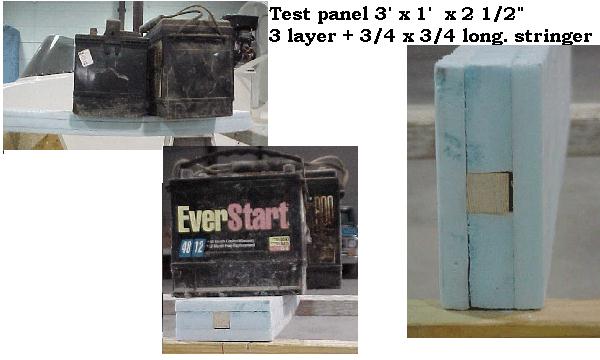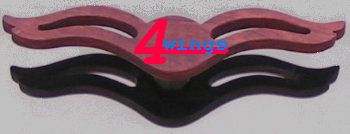|
Hovercraft
hulls - core materials
This chapter is mostly for the lower hull of a
hovercraft or as well a lightweight boat if you consider composite
construction as your choice.
Most Hovercraft , racing or cruising , sailboats as well as high
performance powerboats, and one-design are built with at least one kind
of core in their hull and deck laminates, and for good reason. Cores
make the hull of the craft stiff and light. Stiffness means the hull
does not flex out of shape, which would increase hydrodynamic drag and
slow the craft down. Lightness means less weight to move over or
through the water or land , so speed is faster. In addition, cores
insulate the hull against heat and cold, dampen vibration from engines
as well as slamming seas on boat hulls , and deaden the sound of
chugging engines. Thanks to cores, most craft have better
performance and enhanced comforts.
Cores are made from a variety of materials which have different
strengths and stiffness. Since cores are an integral part of the
crafts structure, the designer and builder must take proper
account of these properties so that hull and deck laminates won't fail.
By understanding how a craft's / boat's structure is designed and how
it works, you can compare these core materials for yourself.
A craft's hull laminate is stiffened by internal members
such as bulkheads and longitudinal stiffeners. These subdivide the hull
laminate into panels. Each panel experiences water pressure, air
pressure if craft on lift and wave impacts from the sea or temporary
ground contact if your hover hight was just not enough. Under these
loads, the panel bends and experiences stresses within the laminate. |
Now lets take a closer look at a little strip from the
middle of a panel. You might think the stresses would be greatest in
the middle of the strip where the bend is greatest. In fact, the
stresses are highest at the ends of the strip. Here, the strip must
handle three kinds of stresses when it bends. In a single-skin
laminate, the outside surface is in tension, the
inside surface is in compression, and the middle is in shear.
Tension and compression are generally easy to visualize. Shear is the
tendency of the inside and outside halves of the laminate to slide
against each other in opposite directions. Shear is highest right in
the middle of the laminate. To resist all these stresses without
fracturing, a single-skin laminate must be relatively thick and
heavy.
In a cored-skin laminate, the outside and inside skins experience the
tension and compression stresses, and the core experiences the shear
stress. Because of this separation of duties, the skins together can be
less thick than the total thickness of its single-skin counterpart.
Cores, however, must be quite thick, and so the total thickness of the
cored-skin laminate is more than a single-skin laminate. Most of the
core materials provide very good flotation and the thicker core has an
attractive side aspect. This makes the cored-skin laminate stiffer. And
because cores are very lightweight, the cored-skin laminate weighs less
than the single-skin laminate while providing flotation to your
craft.
The most common core materials utilized in building boat hulls and
decks include balsa wood, PVC (polyvinylchloride) foam, SAN
(styreneacrylonitrile) foam, and honeycombs made from aramid (Kevlar?),
plastic, and paper. Most widely used throughout the world, balsa core
is made with the wood grain running from skin to skin and is termed
end-grain balsa. The primary developer and major manufacturer of
end-grain balsa core is Baltek Corporation of Northvale, NJ. Baltek
supplies core in densities of 6.5, 9.5 and 15.5 lbs./cu.ft. Just
recently (late 1999), Baltek has announced the availability of
SuperLite?, a range of lightweight balsa cores from 4.9 to 8.7
lbs./cu.ft.
PVC foam cores come in two varieties: cross-linked and
linear (non-cross-linked).
The cross-linked is brittle and, if bent too much, it breaks. It is
available in a broad range of densities, from 3 lbs./cu.ft. to 25
lbs./cu.ft., with 5-10 lb. densities being the most common in
boatbuilding. Cross-linked PVC cores are Divinycell? and Klegecell?,
both marketed by Diab Group of DeSoto, Texas. Diab also markets an
end-grain balsa core called ProBalsa? in densities of 5.6, 9.7, and
13.8 lbs./cu.ft.
Linear PVC is not chemically cross-linked and does not break when bent.
It comes in only two densities, 3.8 and 5.5 lbs./cu.ft. The leading
brand of linear PVC core is Airex?, marketed by Baltek Corporation.
SAN foam is a new core material that has been recently developed. The
one product available is called Core-Cell? which is manufactured and
marketed by ATC Chemical Corporation of Buffalo, NY. Basically, it
combines the linear, non-brittle features of Airex in a broad range of
densities like
Divinycell, from 3-12 lbs./cu.ft.
Honeycombs used to be pretty expensive (some still are), and as such,
were rarely used in production boats and only in the most expensive
one-offs. They are extremely light and usually resemble a bee honeycomb
without the honey. They are made of a number of materials:
- Nomex?, with aramid fiber, is made by Hexcel
Composites, Dublin, CA
- Plastic, Nida-Core?, from Nida-Core Corporation,
Hoboken, NJ
- Paper, called Tricel?, from Tricel Corporation,
Gurnee, IL
Of these, Nomex is the most expensive and is used primarily in custom
boats. Plastic cores are being used increasingly as structural cores in
hulls and decks, and in interior joinery and are my personal choice for
bigger hulls. Paper core is becoming increasingly common in boat
interior joinery, but is not recommended for hull and deck structures.
If paper core gets wet, it goes all mushy, just like cardboard left out
in the rain. As well as it can absorb high amounts of resin if not done
properly.
Now you will tell me that all these core materials have one thing in
common - quite expensive and very often hard to get - after adding
shipping and handling they might not make a lot of sense for a 25'
cruising Hovercraft or a small boat tender you want to build with your
youngster in a few weekends.
So we were looking on for a suitable material especially for small
craft's, which was reasonable in price has halfway decent physical
properties and perhaps you can pick it up at the next hardware store
around the corner. Hard to find - he.
I friend brought once a piece of insulation foam - "try that, they even
use it for airplane wings and rudder ...." A few drinks down the
line I took the piece and placed it in the " Tomorrow " corner -
things to try if we really want to blew some time. There it was
standing for quite a while before it really bugged me to much - looking
at it and still did not try it.
The first attempt was not working out fine - but I have to
admit the easy handling, shaping and relatively simple way to get it
just around the corner made me work a bit more on some scrap panels.
With a few small changes - mostly out of the boat building time this
panel showed better and better performance - take a closer look at this
pictures-
 All sunshine has a certain amount of shadow - down side of this
material is that you have to seal it all the way around with epoxy
resin and not polyester - if not appropriate sealed paint solvents,
gasoline and other chemicals might desolve it and your nice work piece
will be nothing more than a lot of gulp on your shop floor.
All sunshine has a certain amount of shadow - down side of this
material is that you have to seal it all the way around with epoxy
resin and not polyester - if not appropriate sealed paint solvents,
gasoline and other chemicals might desolve it and your nice work piece
will be nothing more than a lot of gulp on your shop floor.
Blue extruded styrofoam is nearly everywhere available where you have a
building supply shop, roofing company, ...
The price is reasonable and it is a great flotation material.
So perhaps you should check it out if it might work for your project.
4wings Main page
- 4wings Yachtservice - Kite-sailer.com - Site-map
|
|
Related
external Links
|

